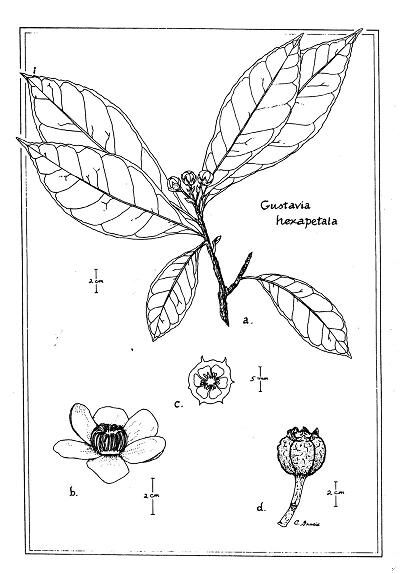Lecythidaceae
Gustavia hexapetala (Aubl.) Sm.

Kingdom: Plantae Rank: Species Parent: Gustavia Status: Valid
Common Names:
- Palo de muerto (Colombia); geniparana (Brazil). - English, Peru
Taxonomic Classification
Classification: The persistent calyx-lobes in the fruit with adaxial inverted y-shaped thickings place this species in Gustavia sect. hexapetala.
Morphological Description
Diagnosis: Usually small trees with dippled bark; calyx-lobes with inverted y-shaped thickenings adaxially; petals white; androecium white on outside, yellow on inside. Fruits globose, costate, golden-yellow at maturity, with six persistent calyx-lobes.
Vegetative Morphology
Habit: Trees, usually understory, to 25 m tall. Trunks not buttressed. Bark scalloped.
Leaves: Leaves from twigs usually <5 mm diam.; petioles 2-17 mm long; blades 8-24 x 3-13 cm, usually oblanceolate or obovate, glabrous; domatia absent; base acute to attenuate, narrowly decurrent; margins usually serrulate, sometimes nearly entire; apex acuminate to attenuate; secondary veins in 9-13 pairs, the tertiary veins reticulate.
Stipules: Stipules absent, especially in adult trees.
Exudate: Exudate absent.
Reproductive Morphology
Inflorescence: Inflorescences terminal, racemose; pedicels 6-30(50) mm long, sometimes narrowly winged (especially in Amazonian Ecuador).
Flowers: Flowers, 6-9(12) cm diam.; calyx lobes 6, usually triangular, with inverted y-shaped thickenings adaxially; petals usually 6, white; androecium white, tinged with yellow on inside, the filaments mostly white, the anthers yellow; ovary (5)6(8)-locular.
Fruit: Fruits indehiscent, globose, costate, 1-3 x 1.2-4 cm, the calyx-lobes persistent, turning yellow and softening at maturity.
Seeds: Seeds with white, straight, poorly developed funicle.
Other
Uses: There are no documented uses of G. hexapetala
Distribution: A wide-spread species found throughout Amazonia in Colombia, Venezuela, Brazil, Bolivia, Peru, and in the Guianas. It is also found north of the Andes in Venezuela at the southern end of Lake Maracaibo and in north central Venezuela in evergreen forest found along steep stream valleys.
Ecology: Gustavia hexapetala is usually found in terra firme forest, but has also been collected from periodically flooded riverine forest.
Chromosome Number: Unknown.
Notes: In Peru flowering collections have been made in Jan, Feb, Aug, and October and fruits have been gathered in Jan, May-Jun, and Aug-Oct. In the Guianas, this species flowers sporadically throughout the year with a peak in flowering from June to October. The flowers of Gustavia hexapetala were visited many times by numerous individuals of Bombus cayennensis between 0900 and 1000 in central French Guiana. The visits were accompanied by load buzzing and presumably the bees were in the process of buzz pollinating the flowers. Several smaller bees were also observed to enter the flowers. The label of Oldeman and Arevalo 32 states that Auca Indians informed the collectors that the “mono mongón” monkey eats the fruits of G. hexapetala. In addition, the label of Daly 6149 reports that monkeys eat the seeds. It is not known, however, if monkeys are dispersal agents or seed predators.
Typification
Type Citation: Sm. in Rees, Cycl. 17: 2. 1819.
Basionym: Pirigara hexapetala Aubl.
Basionym Citation: Aubl., Hist. Pl. Gui. 1: 490-491, t. 193. 1775.
Type Locality: French Guiana. On the Sinnamary River, 40 leagues from it mouth.
Type Collection: Aublet s.n.
Types Deposited at: Holotype: BM; Isotypes: Unknown.
Other Published Figures: Flora of the Guianas. 53: fig. 6 – habit, fl., fr.